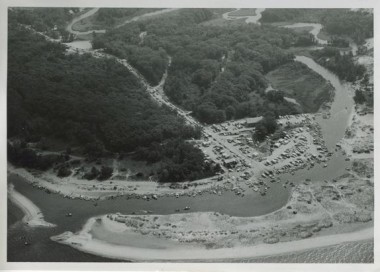Biologists and anglers had attempted to plant salmon in the Great Lakes for more than a century before the spectacular success of the coho and Chinook programs of the late 1960s. Those earlier attempts had always failed, with one notable exception: the accidental release of a species that established itself in all five Great Lakes and continues to reproduce naturally to this day. I wrote a story about it in 1991 for The New York Times:

My friend Dan Donarski with a pink salmon from the St. Mary’s River (photo courtesy the Michigan DNR)
IN THE GREAT LAKES, where trout and salmon can grow to be as large as small children, it’s no wonder that the comparatively diminutive pink salmon is often overlooked. Weighing only two to three pounds each at maturity, they are too small to be targeted by big-game anglers in the open lakes and are usually noticed only in late summer and early fall, when they congregate in rivers to spawn. Anglers who follow the runs use fly rods or ultralight spinning gear, and don’t often have to worry about competition.
Pink salmon—also called humpbacked salmon, for the spawning male’s deformed spine—have an enigmatic history in the Great Lakes. Unlike coho and Chinook salmon, which were transplanted from the Pacific Northwest to enliven a struggling sport fishery, pinks were introduced accidentally. In 1955, eggs from British Columbia were flown to Thunder Bay, Ontario, near the shore of Lake Superior, with the intention of raising them in a hatchery and stocking them far to the north in Hudson Bay. When the hatched fingerlings were loaded onto seaplanes and transported north, however, about 20,000 of them were inadvertently left behind at the hatchery. Rather than allow them to die, attendants released them into the Current River, a tributary of Lake Superior. No one thought any more about them.
A few years later adult pink salmon started showing up in the region’s rivers. Within ten years they were observed spawning in the rapids of the St. Mary’s River, at the outlet of Lake Superior, and in tributaries along the north shore of Lake Huron. In the years since, they’ve established themselves in all the Great Lakes and can be found in such unlikely places as the St. Clair River north of Detroit.
One of the pink salmon’s intriguing qualities is its unpredictability. In the Great Lakes it spawns in the largest concentrations in odd-numbered years, yet good runs can occur during even-numbered years as well. thousands of the fish might appear in a particular river one year, then not the next. They might spawn in abundance in a rock-strewn creek and be absent from a similar creek a half mile down the shore. They tend to show up when you’re fishing for other species, or not fishing at all. Anglers who like to fish for them find themselves frequently outsmarted. Ask them about pinks and they always shake their heads and grin.
Over the years I’ve fished for them quite a few times in the Upper Peninsula, but never with much success. The St. Mary’s River is the most likely place to find them in abundance —tens of thousands of them, some years—but that enormous and very fast river is difficult to fish and the salmon are not always cooperative. One August I joined my friend Dan Donarski, a professional guide and fellow writer, for a couple days of wading the St. Mary’s rapids. We made hundreds of casts of wet flies and streamers over pods of pinks that we saw clearly in the fast current, and managed to get thoroughly skunked. We weren’t alone. In those two days we watched a dozen other anglers catch perhaps fifty salmon, but not one was hooked in the mouth. I spent most of the second day content to observe the small, sleek females, dark on top and white below, and the males with their grotesque humps, industrious and self-important as they darted about over the gravel, chasing away rival males and fanning their early redds. I became convinced that they could not be caught on flies. Of course, a day later Dan called me at my home to say that everyone in the river was catching them.
One recent September I drove for a week along the north shore of Lake Superior in Ontario, stopping now and then to fish the mouths of the many bright, waterfall-and-rapids strewn rivers that tumble into the lake along that coast. The rivers support a heartening variety of gamefish. Any cast can result in a strike from a brook trout, brown trout, lake trout, or steelhead, or from a coho, Chinook, Atlantic, or pink salmon. There’s a good likelihood, too, of catching a pike, walleye, or smallmouth bass.
At one small river, a few hundred feet upstream from the roaring surf of Lake Superior, I cast a Mickey Finn streamer into one of the first deep pools above the mouth. A two-pound fish streaked to the surface, grabbed the fly, and dove immediately back into deeper water. I assumed from its head-shaking fight that it was a brook trout—it would have been among the largest I’d ever caught—and for a few moments I was baffled by the silver, streamlined fish I finally brought to my net. It was obviously a salmonid, but just as obviously not a trout. I thought it might be an immature Atlantic salmon. Then I remembered: Of course, a pink.
Like all Pacific salmon, pinks die after spawning. It’s a fact of life that should make it easy to justify keeping them for a meal. Yet I released mine with the same care I give to wild trout, then laughed when that audacious Mickey Rooney of the salmon family dashed away to resume its important business in the river. I was reminded of Aldo Leopold’s observation about black-capped chickadees: “Everyone laughs at so small a bundle of large enthusiasms.”



2 Replies